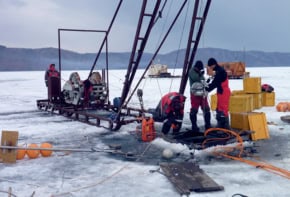The NA48 experiment at CERN has reported a value for direct CP violation - one of the reasons for the dominance of matter over anti-matter in the universe - in agreement with the value reported by the KTeV experiment at Fermilab in February. Both experiments measured the effect in the decay of neutral kaons. Fermilab's claim to have "discovered" direct-CP violation earlier this year led CERN to issue a "point of view" pointing out that its NA31 experiment had published a paper entitled "First evidence for direct CP violation" in 1988. Previous data from the E731 experiment at Fermilab had been consistent with a zero effect, whereas the results from CERN had suggested that the effect was real.
Charge-parity (CP) symmetry implies that particles and antiparticles behave like mirror images of each other. Charge conjugation changes particles into their antiparticles – e.g., electrons become positrons and so on – while parity-reversal is a special type of reflection in which all three directions of space are reversed. In 1964 Andrei Sakharov showed that CP violation was needed to explain why the universe was made of matter rather than anti-matter, even though equal amounts of both should have been created in the big bang.
At one time it was thought that all interactions conserved charge-, parity- and time-reversal symmetry separately. In 1956, however, Chien-Shiung Wu and co-workers showed that parity was not conserved in radioactive beta decay. And in 1964 James Christenson, James Cronin, Val Fitch and Ren‚ Turlay observed “indirect” CP violation, also in neutral kaons.
Although a neutral kaon is a bound state of a down quark and an antistrange quark, “real” kaons are actually quantum mixtures of neutral kaons and their antiparticles. If CP symmetry is conserved, the so-called short-lived neutral kaon, K-short, can decay into two pions, while the long-lived version, K-long, cannot. Cronin, Fitch and co-workers observed that about 1 in 500 long-lived kaons decayed into two pions, thus violating CP symmetry. This effect can be shown to be due to the fact that the K-short and K-long particles both contain about 0.3% more of the neutral kaon than its anti-particle.
However, the Standard Model of particle physics also allows for “direct” CP violation in the decay of particles. This effect is measured by a ratio known as e‘/e which is defined in terms of the ratio of four decay rates: K-long into two charged pions, K-long into two neutral pions, K-short into two charged pions, and K-short into two neutral pions.
The latest value from CERN, based on an analysis of 10% of the data from the NA48 experiment, gives a value of 18.5±7.3´10-4 for the effect, which is in agreement with the KTeV value of 28.1±4.1´10-4. Although both values are higher than theorists had been expecting, the uncertainties in the calculations are large and it should be possible to accommodate the results within the Standard Model of particle physics.
A different measurement of direct CP-violation is underway at the KLOE experiment in Frascati, Italy, and a new generation of so-called


